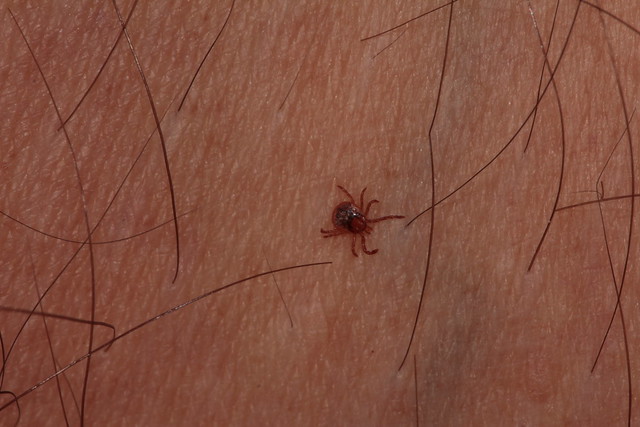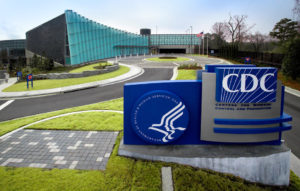Is the Pentagon Behind the Rise in Lyme Disease?
"Bitten" author Kris Newby presents her case that the U.S. military has weaponized ticks and unleashed them on an unsuspecting public. John Brandauer / Flickr
John Brandauer / Flickr
What follows is a conversation between “Bitten” author Kris Newby and Jacqueline Luqman of The Real News Network. Read a transcript of their conversation below or watch the video at the bottom of the post.
JACQUELINE LUQMAN: Hi, I’m Jacqueline Luqman with The Real News Network.
A new book published in May has raised questions about the origins of Lyme disease, which affects 400,000 Americans each year. And this book has caught the attention of Congress, prompting some to ask the question, did the Pentagon weaponize ticks and unleash them on an unsuspecting public? Here to talk about this is Kris Newby, the author of Bitten: The Secret History of Lyme Disease and Biological Weapons. Kris is an award-winning science writer at Stanford University and the Senior Producer of the Oscar shortlisted documentary on Lyme disease, Under Our Skin. Thank you so much for joining me today, Kris.
KRIS NEWBY: Thank you for the invitation.
JACQUELINE LUQMAN: So Lyme disease is not a new phenomenon, right? It’s not new. It’s been around for a long time. But what is it about Lyme disease that has turned more attention on this issue now?
KRIS NEWBY: The Lyme disease bacterium was discovered or announced that it was discovered in ’81, and the tick-borne disease problem has just continued to increase since that time. What my book shows is not that the Lyme disease bacterium is a bio weapon, but the epidemic of tick-borne diseases. There was three new tick-borne diseases sort of noticed in 1968, and those may be related to a biological weapons accident associated with the weaponization of ticks that may have had multiple germs inside of them.
JACQUELINE LUQMAN: Now, that’s the secret history of Lyme disease that you talk about in your book— that people obviously don’t know anything about— that ties Lyme disease to the Pentagon and the creation of bio weapons or using ticks and other insects as bio weapons possibly. Can you explain for us what that alleged program was about?
KRIS NEWBY: Well, ticks were used as basically eight-legged soldiers. And the military, the bio weapons headquarters in Fort Dietrich, Maryland, figured out how to put dangerous diseases inside the ticks. And then they had a program where they would drop those ticks on enemy territory from a plane, and then those ticks would be like stealth soldiers and it would be hard to protect yourself from them and they would bite people. And they would either transmit fatal or incapacitating diseases to the local population that would make it easier for an invading army who had been vaccinated to take over the area and less destructive than traditional bombs.
JACQUELINE LUQMAN: Now, I know that for some people watching this, they may say, “Okay, this sounds really ridiculous. Weaponized ticks? Come on now.” But there is a key figure referenced in your book who actually lends credence to this idea because this is not something, from what I understand, that you discovered. This was something that you were given information on from this key figure. So who was this person and why is he important to not just this program of weaponized ticks and insects, but also to the history of Lyme disease? Who was this person?
KRIS NEWBY: This person was Willy Burgdorfer, a medical zoologist who came over from Switzerland in 1951, landed in the Public Health Service in Hamilton, Montana— that was the number one spot for tick research—and he was very shortly enlisted in the biological weapons program headquartered in Frederick, Maryland. His job was to weaponize fleas, ticks, and mosquitoes by putting dangerous diseases in them so that they could be dropped on the enemies. Now, in 2013, he told a filmmaker and me pieces of the story where he admitted that he had been in the biological weapons program for over 10 years and no one had known that. And he’s also the discoverer of Lyme disease, and that’s what really made him world-renowned. So for him to say that, that he had been covering this up for so many years, makes it somewhat credible.
JACQUELINE LUQMAN: Now, the Representative from New Jersey, Chris Smith, who is a Republican and has introduced an amendment to have the Department of Defense’s Inspector General investigate whether this program actually did exist and whether the Pentagon has weaponized ticks and other insects and unleashed them on the public, has just been voted on and it was proved to be – I think the next step is that it would be reconciled to the Senate bill and it may not make it through the full and final defense budget, but it is true that there has been a rise in Lyme disease cases over the past decade or so.
So these two events have coincided, the release of your book and also the rise in Lyme disease cases, which for some people does cause some alarm. As a matter of fact, the CDC has documented this rise in their recent study called “Lyme and Other Tick-Borne Diseases Increasing.” Now, they cite that the new germs contributing to Lyme disease and other tick-borne diseases have been identified. The geographic range of the tick population is expanding, and that can be contributed to over-development of wooded areas, destroying the ecosystems of insects and also climate change. But can those contributing factors account for the entirety of the rise in Lyme disease cases? I guess what I’m asking is, can we rule out the possibility that the Pentagon may have unleashed weaponized ticks and other insects onto the American public or in some areas and it got out of hand?
KRIS NEWBY: I think it’s absolutely proven that there was a tick weapons program. The outstanding question is, was there an accident where some of the infected ticks got out? And maybe they didn’t know they were infected and they were. And there was also aerosolized programs where germs that can be caused by ticks were sprayed over in open air conditions, and did that enter the ecosystem that way? So it can’t be ruled out. And there has been a mystery as to why these three new dangerous virulent tick-borne diseases showed up around Long Island Sound. That’s New Jersey, New York, Connecticut, Rhode Island, and Massachusetts, in 1968, around 1968. And so, in nature, it would be highly unusual for three brand new pathogens to just show up unless there was some sort of manmade intervention.
So that’s the hypothesis of my book. And I go through and present evidence of the development of the tick-borne research program, tick-borne disease research program, accidents that have happened in the past with the ticks, and then Willy’s confession and supporting information to that admission that he thought the outbreak was due to a bio weapons release. He never said it was the Lyme bacteria per se. He intimated it was a different bacterium. But that may be why it’s been confusing to scientists and we need to look into it now with this new information, and that would speed up our development of diagnosis, treatment and cures.
JACQUELINE LUQMAN: So you’re saying that people are kind of conflating ideas. People are saying, or making the, I guess accusation, that you’re saying that Lyme disease itself was the result of a weaponized tick program from the Pentagon. But you’re saying that there were other pathogens that were discovered at the same time that the Lyme pathogen was discovered and in a scientific process, that’s unheard of. So these other-
KRIS NEWBY: Unlikely. Unlikely.
JACQUELINE LUQMAN: Unlikely. So the appearance of these other pathogens at the same time that are related, point to something outside of just a natural occurrence.
KRIS NEWBY: Right. And also, strange new species of ticks out of their natural habitat. For example, the Lone Star tick, which is very aggressive and man-biting and spreads disease faster than the traditional native ticks in and around Long Island. So there are documented reports about Lone Star ticks being released in Norfolk, Virginia on the coast, and a year after those experiments, they’re around Long Island. And so it appears that birds helped spread them farther north.
JACQUELINE LUQMAN: Now, the interesting thing about this story is that as fast as it has come out and there has been attention given to it, some in the more established media circles have already come out and tried to discredit, not necessarily your book. They have not tried to do that directly, but they’ve tried to discredit interestingly enough, Dr. [Burgdorfer]. In a Washington Post article, they quote a scientist who says this of Dr. [Burgdorfer]. The scientist is Michael T. Osterholm, the Director of the Center for Infectious Disease Research and Policy at the University of Minnesota. And he said of Dr. [Burgdorfer] that there’s just no credible evidence behind the stories about weaponizing ticks … or Burgdorfer’s … I’m sorry, I mispronounced his name … Dr. Burgdorfer’s involvement with such a project. What do you say to this claim that there is no credible evidence behind the man who you admitted, you said yourself identified the Lyme pathogen, also saying that the Pentagon was weaponizing ticks with not just that pathogen but others?
KRIS NEWBY: Well, I have him on video saying he weaponized ticks and I have a plethora of documents confirming that, including a progress report to the NIH Director saying Willy Burgdorfer is an outstanding employee and he’s been for three years working on classified programs for the Army that involves ticks. So I would say to Dr. Osterholm, I hope you read the book and then perhaps you’ll be convinced.
JACQUELINE LUQMAN: So you have a paper trail proving that Dr. Burgdorfer was an employee of the Department of Defense and that he was a part of this program and worked on this program.
KRIS NEWBY: He was an employee of the NIH, but he had contracts from Fort Dietrich, Maryland to do many, many biological weapons experiments. So I have quite a long paper trail to that, and it’s all posted publicly on the various archives.
JACQUELINE LUQMAN: And it’s all in your book?
KRIS NEWBY: Yeah, I mean, the key evidence. There’s much more, as you can see behind me. It’s all there.
JACQUELINE LUQMAN: So ultimately, let’s go back to this amendment that representative Chris Smith has introduced, which he says is partially inspired by your book, not entirely, but partially inspired by your book and other articles on this subject. As I said, this amendment has to be reconciled to the Senate defense bill. It may not make it into the final approved bill for the Department of Defense, and if that doesn’t happen, if there’s no investigation into this issue, what do you want people to understand about this issue? Is this just another one of those kind of general, “Don’t trust the government,” conspiracy theories or is there really something here that we should take very seriously?
KRIS NEWBY: Well, I’ve been working on this book for five years and then through the documentary that’s another five years, I can say with some authority that the tick-borne epidemic in the US is reaching really serious levels, and the CDC certainly has come out this year to support that premise. I think everybody now knows somebody who has Lyme disease and they have a horror story. And so this denialism—I have to be really clear, it’s not just Lyme disease. It’s the co-infections, too. So when you have the Lyme bacteria plus the co-infections, which may or may not have bio weapons’ ancestry, you get this really bad chronic disease. We need to quit denying that this is a problem and start trying to understand what’s in the ticks, where are they spreading, and we need to develop treatments for the people with the chronic forms of tick-borne diseases. I mean, for Lyme disease alone, there’s only been I think five to seven randomized treatment trials. The last one was 18 years ago, and that’s not good enough for the rate at which these diseases are spreading.
JACQUELINE LUQMAN: So people are suffering from a disease that is spreading far rapidly than the research for the treatment or even the attention that the medical community should be paying to it, is keeping pace with it.
KRIS NEWBY: Right. I think there’s been a hyper focus on Lyme disease only and the scientists who have all the grants to study it are saying, “Oh, Lyme disease is easy to treat, easy to cure, and if you have lingering symptoms, then you’re a hypochondriac or you have an autoimmune disease.” And I’m hoping that the book opens their eyes to look at the co-infections that might be worsening the original Lyme infection in these people.
JACQUELINE LUQMAN: Well, we will be fascinated to see what will happen with this amendment that has been introduced by Representative Chris Smith that was partially inspired by the book Bitten: The Secret History of Lyme Disease and Biological Weaponsthat was written by Kris Newby. Thank you so much, Kris, for joining me to talk about your book and this issue today. It was a wonderful conversation and fascinating.
KRIS NEWBY: Thanks so much.
JACQUELINE LUQMAN: And thank you for watching. This is Jacqueline Luqman and this is The Real News Network in Baltimore.
Your support matters…Independent journalism is under threat and overshadowed by heavily funded mainstream media.
You can help level the playing field. Become a member.
Your tax-deductible contribution keeps us digging beneath the headlines to give you thought-provoking, investigative reporting and analysis that unearths what's really happening- without compromise.
Give today to support our courageous, independent journalists.






You need to be a supporter to comment.
There are currently no responses to this article.
Be the first to respond.